Lecture 13
Market for Pollution: Price vs. Quantity Approaches
November 7, 2025
Market for Pollution: Price vs. Quantity Approaches
❓ Why Not Just Regulate?
“If the government knows the socially optimal level of pollution, why not just mandate it directly?”
- Regulation (quantity control) has been the traditional approach, since it seems straightforward:
- 1970s: U.S. limited SO₂ emissions rather than taxing them.
- 1987: Global ban on CFCs to protect the ozone layer instead of taxing them.
- 1970s: U.S. limited SO₂ emissions rather than taxing them.
- For climate change, however, economists highlight market-based policies that use prices or permits to guide behavior.
- Carbon taxes (price-based) and cap-and-trade (quantity-based) are the two main policy instruments for reducing GHG emissions.
- Let’s examine when each—price or quantity—is more effective for achieving climate goals.
🌍 Climate Policy Instruments: The Core Idea
| Approach | Instrument | Mechanism | Examples |
|---|---|---|---|
| Price-based | Carbon Tax | Sets a price per ton of CO₂; firms reduce emissions until MC = tax. | Sweden CO₂ tax; Canada’s national carbon pricing system |
| Quantity-based (with flexibility) | Cap-and-Trade | Sets a cap on total emissions; firms trade emission permits until permit price = MC. |
European Union Emissions Trading System (EU ETS); California’s Cap-and-Trade Program |
Goal: Achieve climate targets at the lowest total social cost.
🔄 From Goods to Pollution Reduction
To compare price and quantity approaches effectively, we must shift focus:
From the market for a product (like automobile)
→ to the market for pollution reduction (like CO₂) itself.
- In basic models, the only way to cut pollution was to reduce output.
- In reality, firms can also adopt cleaner technologies:
- Power plants install CCUS to capture CO₂.
- Cars use catalytic converters to reduce NOₓ emissions.
- Power plants install CCUS to capture CO₂.
👉 This shift helps us analyze abatement decisions directly — how firms respond to taxes (prices) or caps (quantities) when multiple reduction options exist.
⚙️ Market for Pollution Reduction: Carbon Market
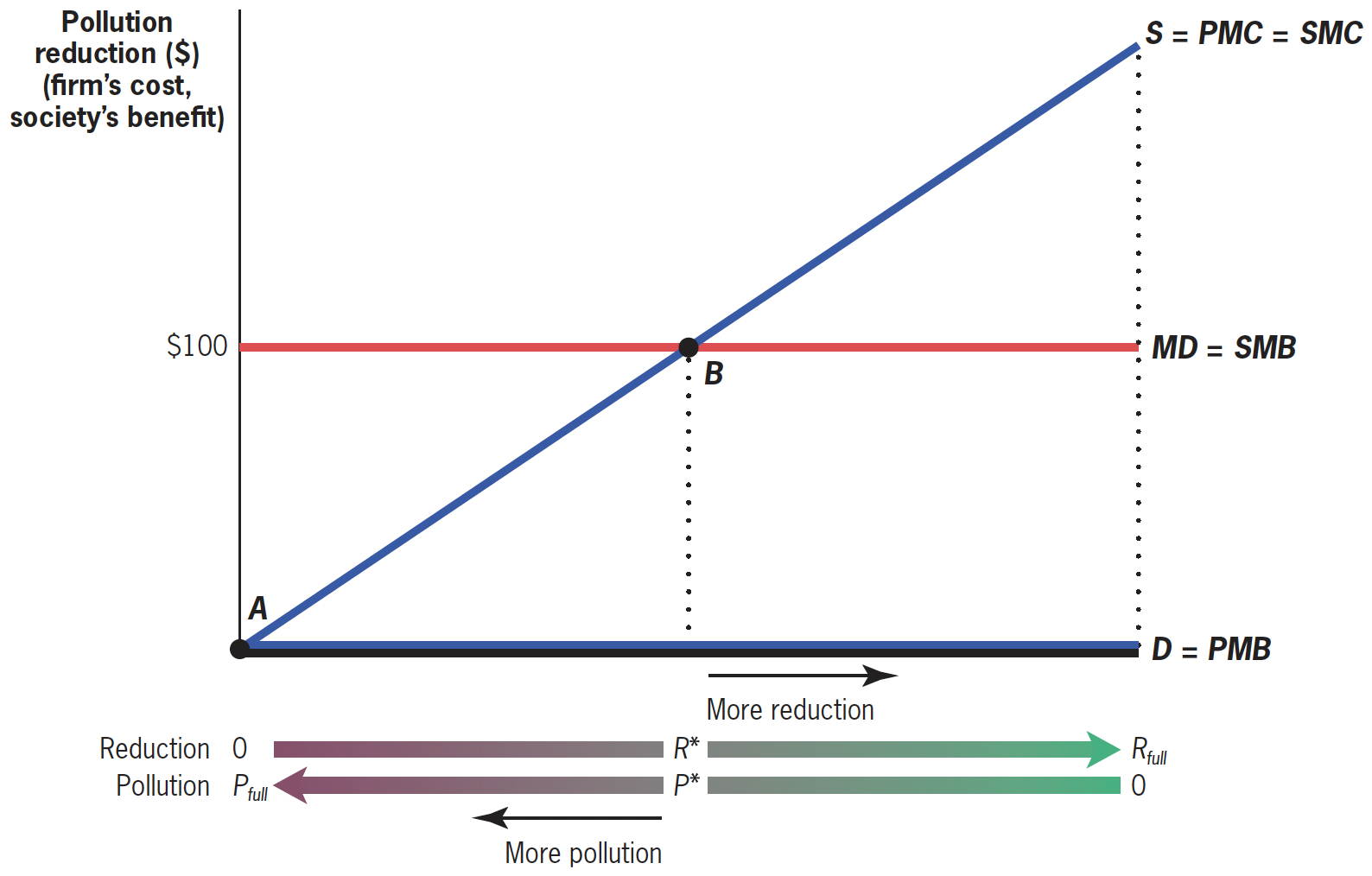
- Marginal Damage (MD) equals SMB — each unit of reduction prevents one unit of harm to society.
- Private MC (PMC) equals Social MC (SMC) — there are no externalities in pollution reduction itself.
- \(A\): Free market outcome occurs where PMC = PMB — with no incentive to reduce pollution.
- \(B\): Optimal outcome occurs where SMC = SMB.
💸 Price Regulation: Carbon Tax
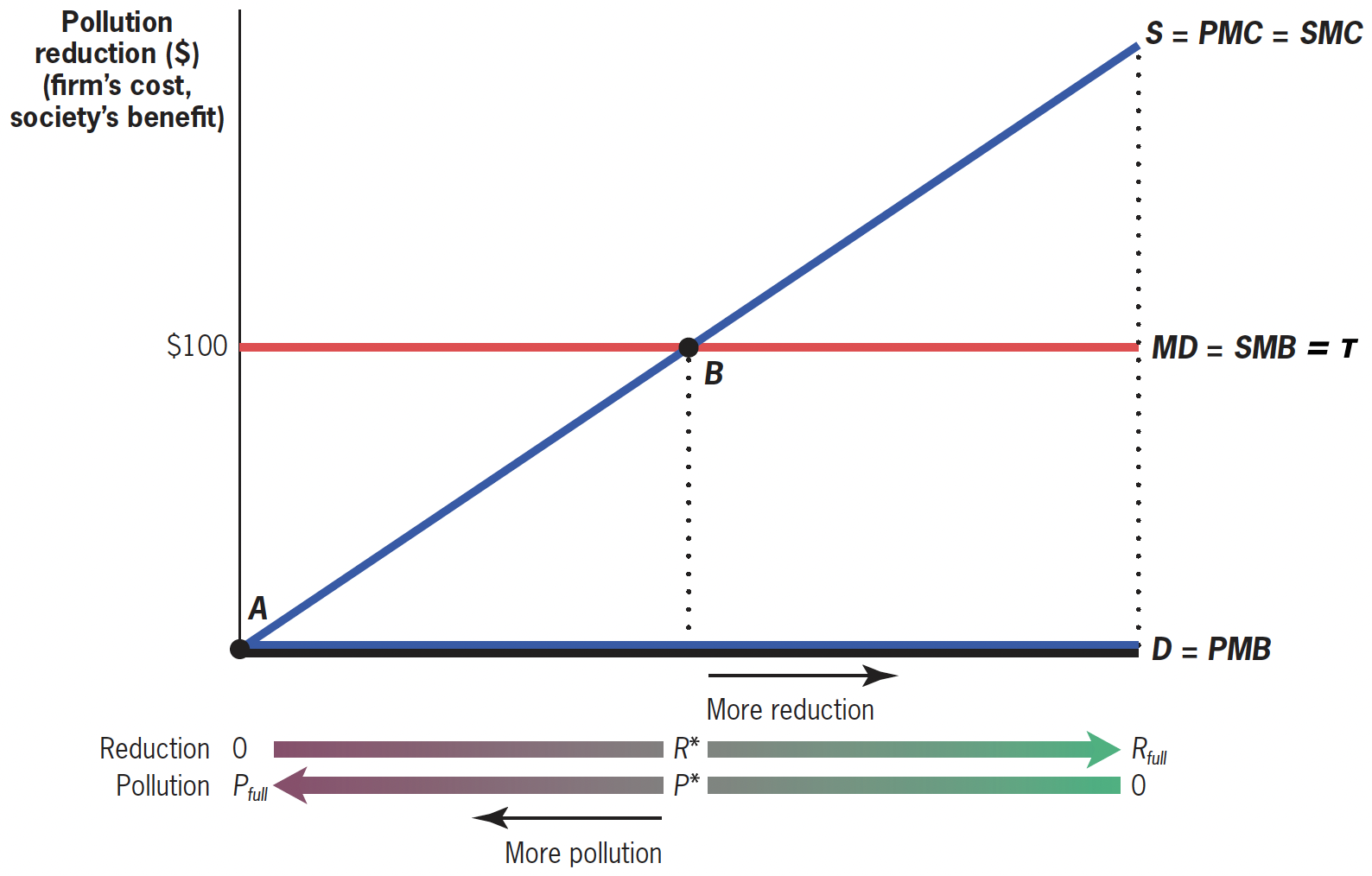
- Government imposes a Pigouvian tax (τ) on each unit of pollution equal to its marginal damage (MD) — for example, $100 per ton of CO₂.
- Each plant reduces emissions as long as its marginal abatement cost (MC) is below τ, and pays the tax on remaining emissions.
- Once MC = τ, further abatement would cost more than the tax, so the firm stops reducing.
📏 Quantity Regulation: Mandated Reduction
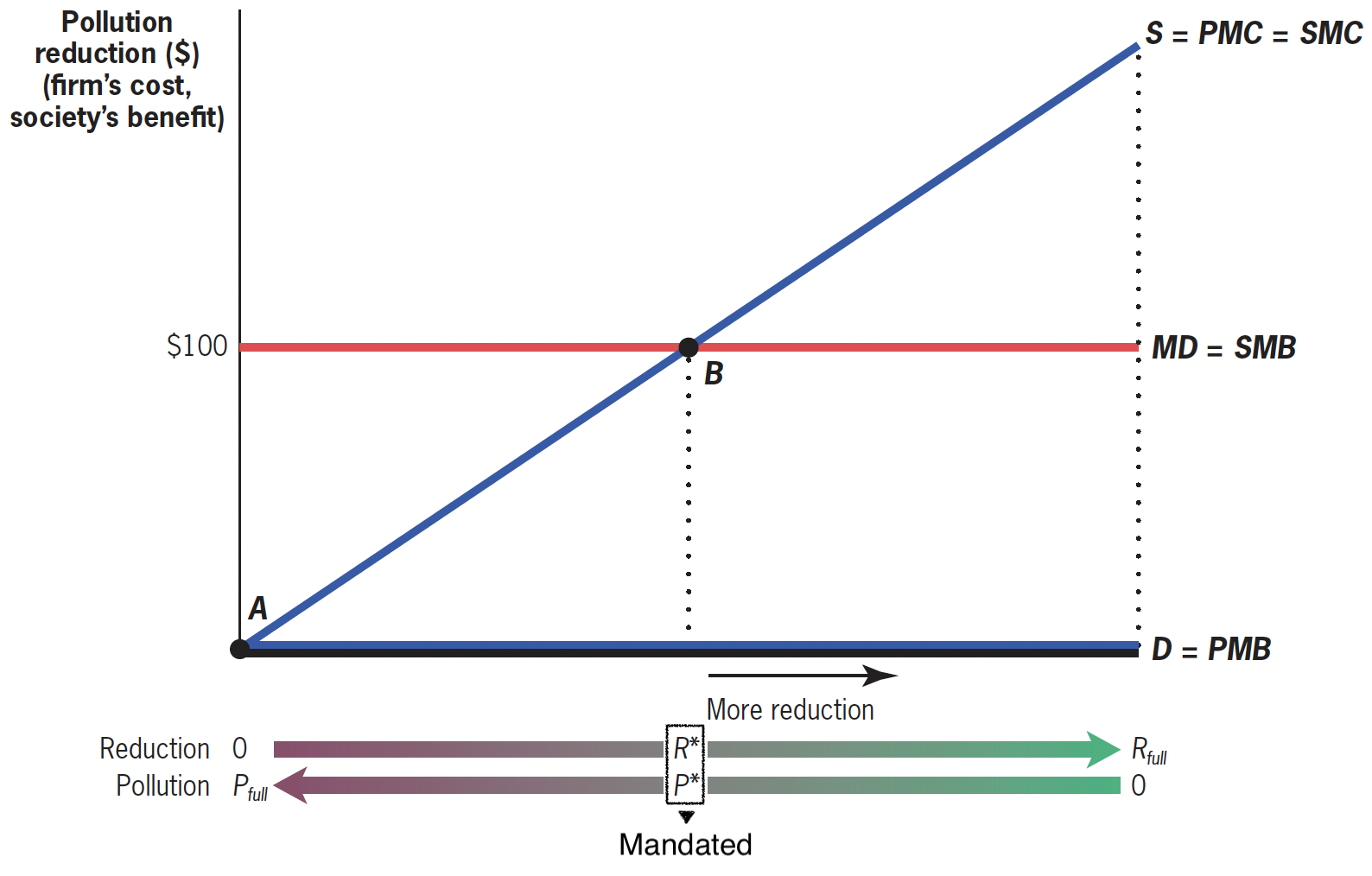
- Regulation: Government simply mandates that firms reduce pollution by the optimal amount (R*).
Note
- If MD is constant, this is manageable; but when MD declines with more reduction, the regulator must know both MD & MC curves to determine either the optimal tax or the optimal quantity.
Heterogeneous Plants
🏭 Heterogeneous Plants
We now consider a case with two plants that have different marginal abatement costs (MC) — a more realistic setting for policy design.
| Plant | MC | Efficient Reduction (example) |
|---|---|---|
| A (newer tech) | Lower | 150 |
| B (older tech) | Higher | 50 |
- In reality, firms differ in technology, age, and fuel mix, leading to unequal costs of pollution reduction.
- This setup helps us compare how quantity regulation (like command-and-control) and price-based policies (like a carbon tax & cap-and-trade) perform under realistic conditions.
Note
- Command-and-control regulation: Government mandates specific pollution reductions or sets technology standards that firms must follow directly to control emissions.
🏭 Heterogeneous Plants: Command-and-Control
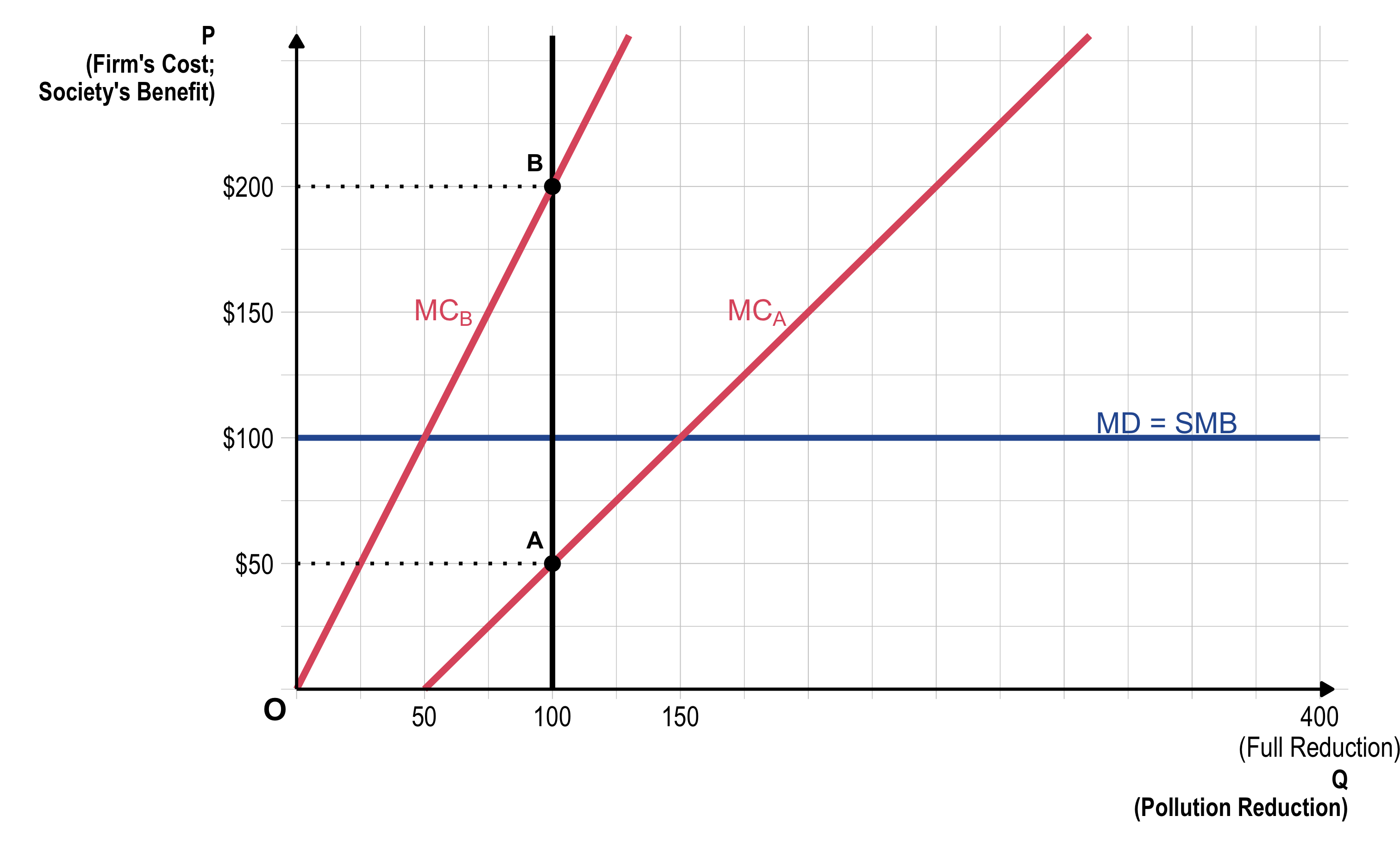
- Equal command-and-control cuts (e.g., 100 units each) simplifies enforcement and compliance — every firm follows the same rule.
- Total Social Cost of Pollution Reduction
\[ \underbrace{\frac{1}{2}\times(100-50)\times50}_{\text{Plant A}} + \underbrace{\frac{1}{2}\times100\times200}_{\text{Plant B}} = \$11,250 \]
🏭 Heterogeneous Plants: Price Regulation
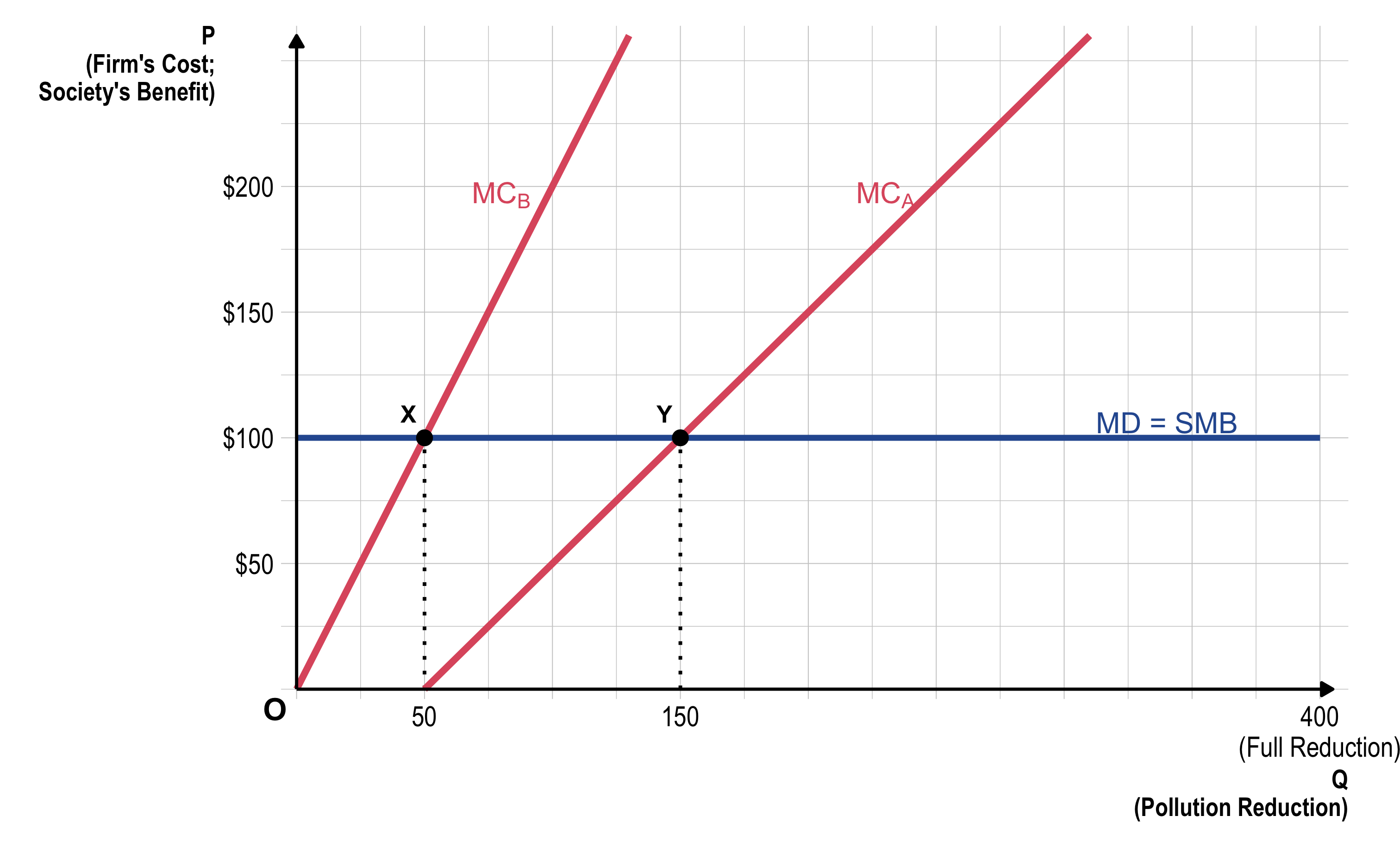
- Under a Pigouvian tax (τ = MD), each firm decides how much to reduce pollution.
- Firms abate until their marginal cost (MC) equals the tax rate (τ).
- Total Social Cost of Pollution Reduction
\[ \begin{aligned} \underbrace{\frac{1}{2}\times(150-50)\times100}_{\text{Plant A}} + \underbrace{\frac{1}{2}\times50\times100}_{\text{Plant B}} = \$7,500 \end{aligned} \]
🏭 Heterogeneous Plants: Quantity with Flexibility
- The government sets a total emissions cap (e.g., 200 permits, socially optimal level of pollution) and lets firms trade them.
- Each permit allows one unit of pollution. (Coase Theorem!)
- A firm will:
- Abate if its MC is less than the permit price → cheaper to clean than to buy.
- Buy permits if its MC is greater than the permit price → cheaper to pollute than to clean.
- Trading continues until no further mutually beneficial trades exist — just like in a Coase bargain.
- Abate if its MC is less than the permit price → cheaper to clean than to buy.
MCA(QA) = MCB(QB) = Permit Price.
(Because the cap is the socially optimal level,) Permit Price = MD.\(\qquad\qquad\quad\;\)
- The result: the pollution target is met at the lowest total cost.
–> –> –> –> –>
🏭 Heterogeneous Plants: Summary
| Policy Type | What Is Set (Policy Lever) | Who Decides Reduction? | Efficiency |
|---|---|---|---|
| Command-and-control | Set reduction amount (e.g., 100 each) | Government mandates cuts | ❌ Inefficient if abatement costs differ |
| Price Regulation (Tax) | Set price per unit (τ) | Firms choose abatement | ✅ Efficient — firms reduce until MC = τ |
| Cap-and-Trade | Set total emissions cap | Firms trade permits | ✅ Efficient — firms trade until MCₐ = MCᵦ = permit price |
- ⚖️ Command-and-control regulations are simple but often inefficient.
- 💡 Market-based instruments — such as carbon taxes and cap-and-trade — let firms decide how much to abate based on their own costs.
- This flexibility ensures the Cost-Effectiveness (Equimarginal) Principle holds: MCs become equalized across firms, leading to an efficient allocation of abatement.
- ✅ Result: the climate target is achieved at the lowest total social cost.
Uncertainty about Costs of Reduction
🌫️ Uncertainty about Costs of Reduction
- In reality, marginal abatement costs (MC) are uncertain — policymakers may not know the exact cost of cutting pollution.
- They can estimate the overall MC curve, but cannot know its exact slope or position when designing policy.
- This uncertainty means the actual abatement level may differ from what policymakers intended — the socially optimal level.
- The welfare loss from being wrong depends on how sensitive marginal damages (MD) are to changes in emissions.
- Under uncertainty, the preferred policy instrument — price (tax) or quantity (cap) — depends on the slope of the MD curve:
- If MD is steep, errors in abatement lead to large welfare losses.
- If MD is flat, errors in abatement cause only minor welfare impacts.
Case 1: Flat Marginal Damage - Tax

Case 1: Flat Marginal Damage - Cap-and-Trade
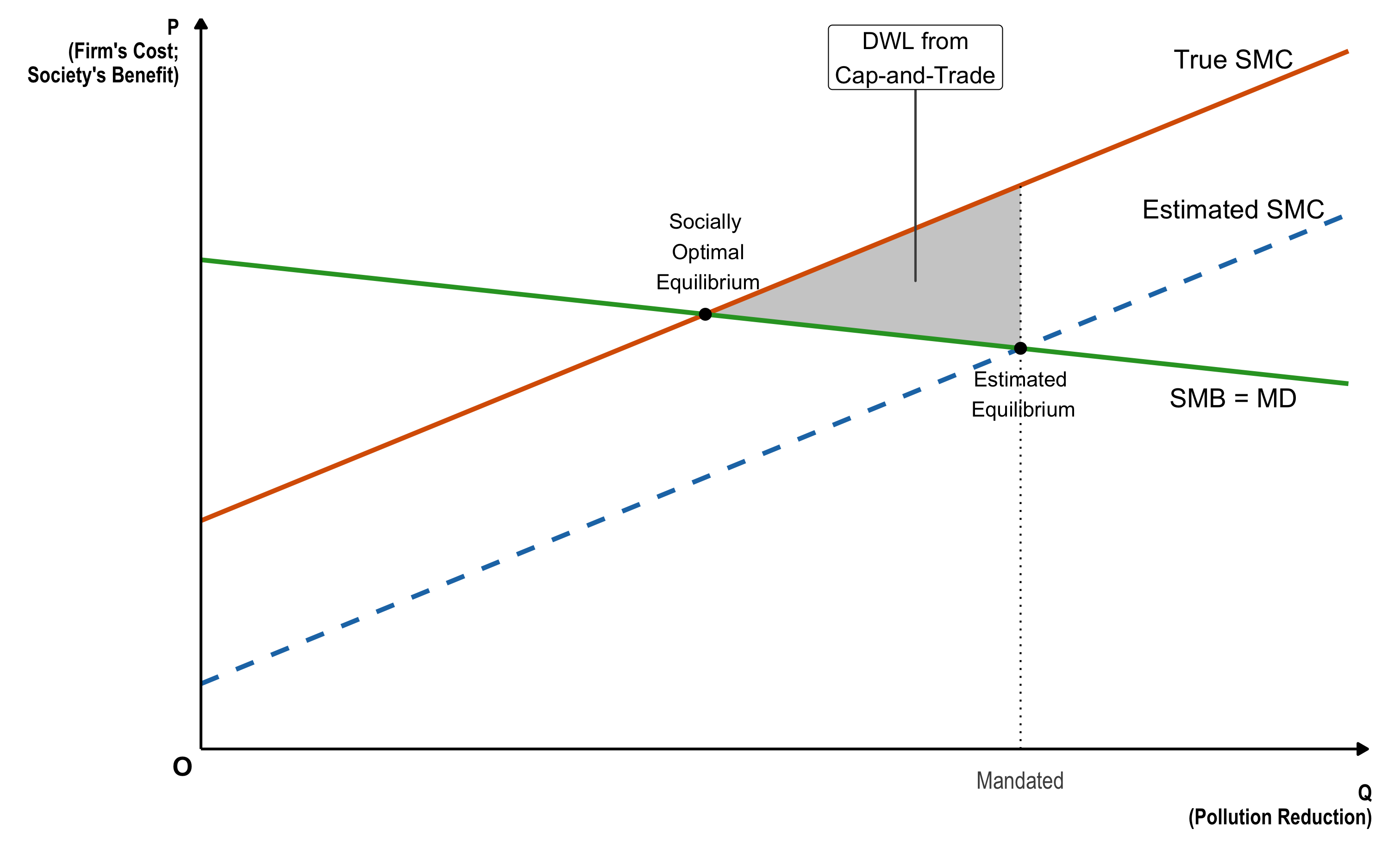
Case 1: Flat Marginal Damage

Tax

Cap-and-Trade
- If the marginal damage (MD) curve is flat (damage changes little with small emission changes)
→ Taxes (price instruments) are preferred.
Case 2: Steep Marginal Damage - Tax
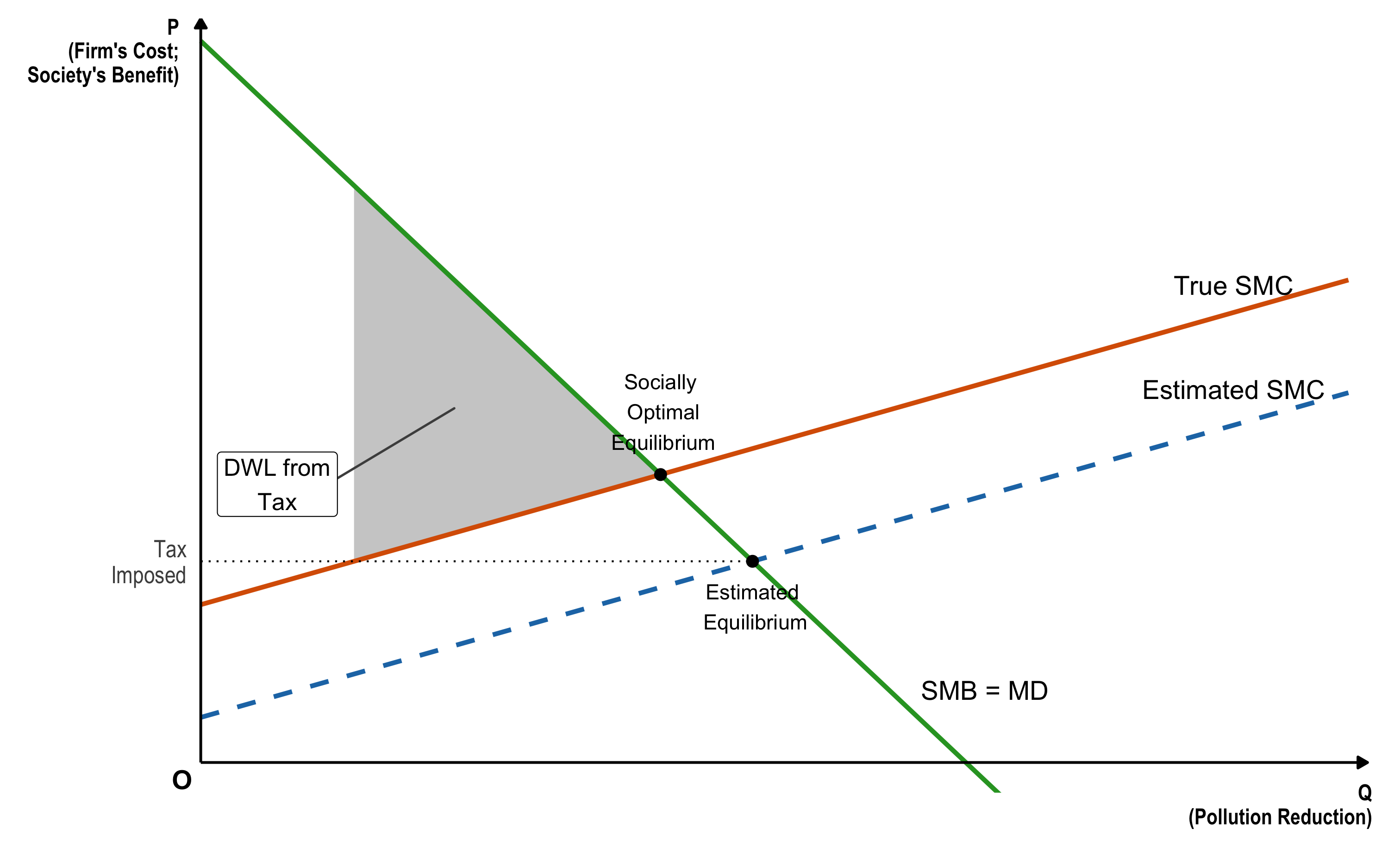
Case 2: Steep Marginal Damage - Cap-and-Trade
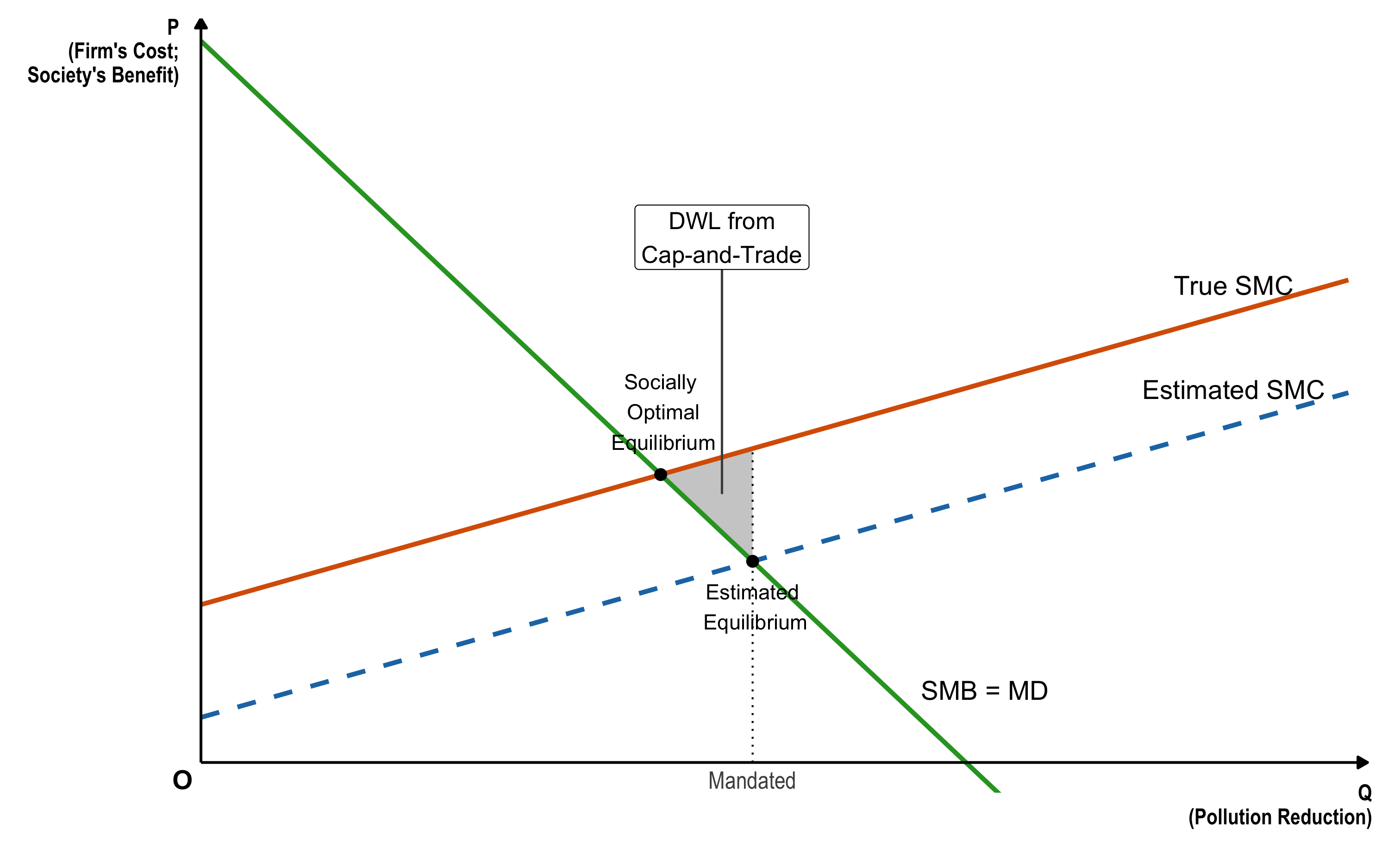
Case 2: Steep Marginal Damage

Tax

Cap-and-Trade
- If the MD curve is steep (damages rise sharply with small emission increases)
→ Quotas or cap-and-trade (quantity instruments) are preferred.
🌍 Climate Change and Policy Design:
Stock vs. Flow

- Question: Under uncertainty, consider two cases —
a flat marginal damage (MD) curve vs. a steep MD curve.
- 👉 Which case best represents climate change?
(Hint: the benefits of emission reductions depend on the stock of CO₂, not short-term fluctuations in flow.)
🌍 Climate Change and Policy Design
Carbon Tax vs. Cap-and-Trade
- The benefits of emissions reductions are linked to the stock of greenhouse gases in the atmosphere.
- What matters for climate damage is the total accumulated CO₂, not short-term fluctuations.
- The costs of emissions reductions are tied to the flow of emissions —
how much we cut this year or in the near term.
💡 The marginal benefits of emission reductions are insensitive to the current level of abatement
→ small short-run emission changes have little effect on total warming.
- Under uncertainty about abatement costs, a carbon tax is preferred to cap-and-trade for stock pollutants like CO₂ , because emission errors are low-cost, while price errors can be large.
🌍 Carbon Pricing in Practice: Carbon Tax vs. Cap-and-Trade
⚖️ Price vs. Quantity: The Policy Trade-off
- Policymakers face a fundamental trade-off between:
- Achieving a specific emissions target with certainty, and
- Ensuring stable and predictable costs for firms and consumers.
- Achieving a specific emissions target with certainty, and
Carbon Tax
- Provides price certainty — firms know exactly what a ton of CO₂ costs.
- But emissions outcomes can fluctuate with energy demand and economic cycles.
Cap-and-Trade
- Provides environmental certainty — a fixed cap on total emissions.
- But abatement costs can vary widely depending on shocks and economic conditions.
📄 Carbon Tax — Big Advantages
- Simple & Transparent
- Requires fewer new institutions and less administrative complexity.
- Adapts to Technological Change
- If abatement costs fall or cleaner technologies become cheaper, a carbon tax leads to greater emissions reductions because firms cut more whenever it becomes cost-effective.
- Under cap-and-trade, lower abatement costs simply push permit prices downward:
- Demand for permits falls, but supply is fixed → permit prices drop.
- Total emissions stay capped, so the overall quantity doesn’t fall—and some firms may even emit more because compliance has become cheaper.
🗺️ Global Map of ETS and Carbon Taxes

Source: World Bank (2025)
📊 Share of Global GHG Emissions Covered by an Emission Trading System (ETS) or Carbon Tax
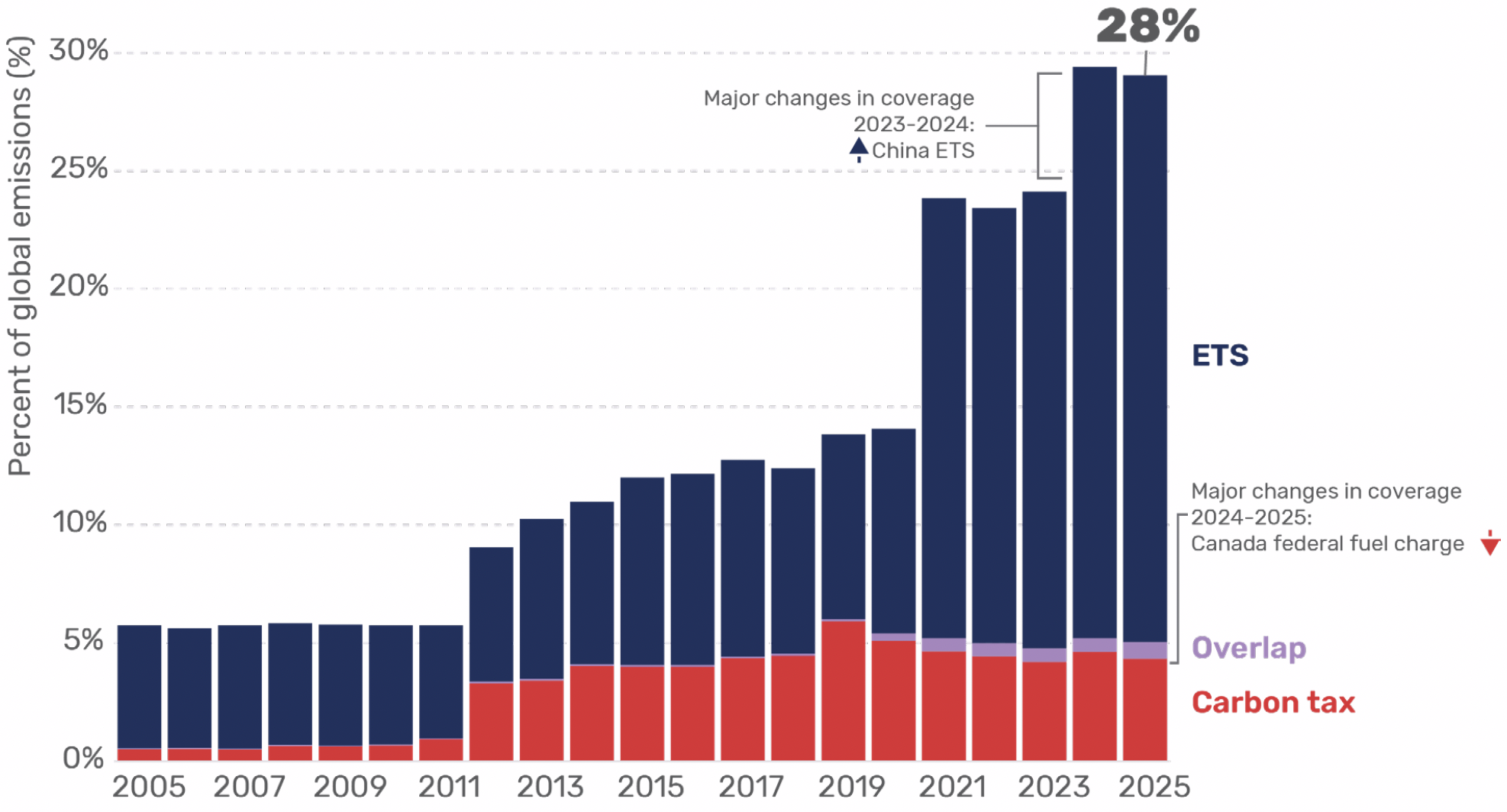
Source: World Bank (2025)
🌍💰️ Emission Coverage and Pricing Level
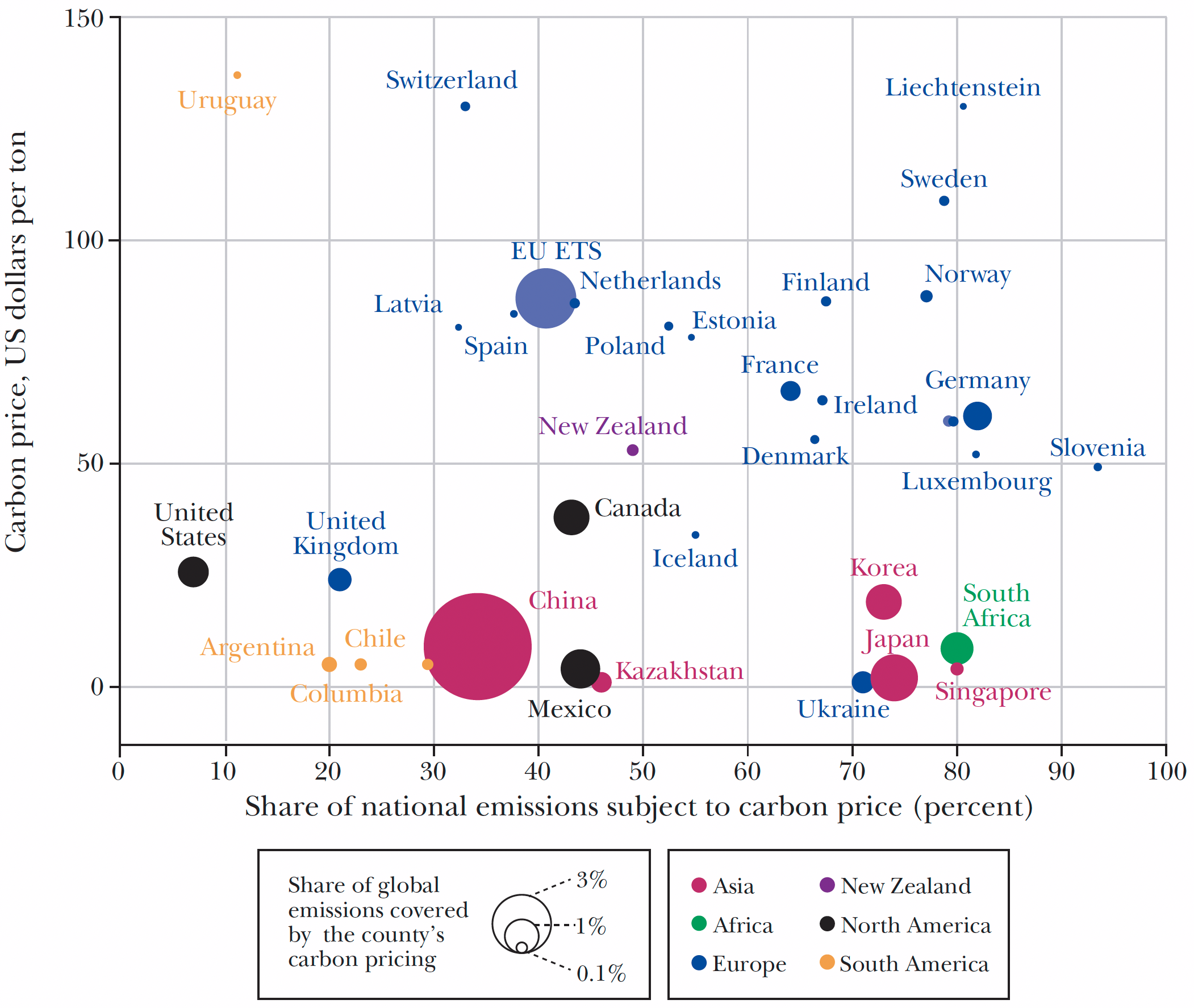
Source: World Bank (2025)
🎯 Why Cap-and-Trade Is More Popular in Practice
“It has become too politically divisive and a distraction from the important issues we are tackling.” Government of British Colombia, “B.C. Eliminates Carbon Tax,” (March 31, 2025)
- Even though economists often prefer carbon taxes (price stability + administrative simplicity), cap-and-trade is more politically feasible:
- It avoids the politically sensitive term “tax,” reducing public resistance.
- Introducing a new tax is often politically infeasible, even when it is economically efficient.
- It enables governments to grant free permits in the early stages, helping secure industry buy-in.
- It is presented as a flexible, market-driven mechanism, which appeals to policymakers and firms.
- It avoids the politically sensitive term “tax,” reducing public resistance.